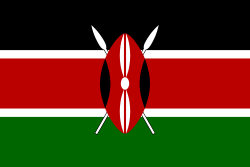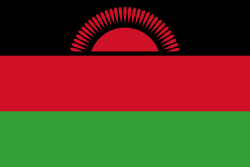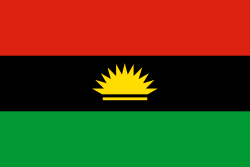Top Qs
Timeline
Chat
Perspective
Pan-African flag
Flag using the Pan-African colours From Wikipedia, the free encyclopedia
Remove ads
The Pan-African flag (also known as the Afro-American flag, Black Liberation flag, UNIA flag, and various other names) is an ethnic flag representing Pan-Africanism, all peoples of African descent, and/or black nationalism.[1][2][3] A tri-color flag, it consists of three equal horizontal bands of (from top down) red, black, and green.[4] August 17 - the birthday of Marcus Garvey, is celebrated as Universal African Flag Day.
The flag was created as a response to racism against African Americans in 1920 with the help of Marcus Garvey.[5]
The colours were likely influenced by the older Pan-African colors, substituting yellow for black to promote racial pride.
The Universal Negro Improvement Association and African Communities League (UNIA-ACL) formally adopted it on August 13, 1920, in Article 39 of the Declaration of the Rights of the Negro Peoples of the World, during its month-long convention at Madison Square Garden in New York City.[6][7] Variations of the flag can and have been used in various countries and territories in the Americas to represent Garveyist ideologies.
Remove ads
History
Summarize
Perspective

The flag was created in 1920 by members of UNIA in response to the "coon song" that became a hit around 1900, titled, "Every Race Has a Flag but the Coon".[8][9] This song has been cited as one of the three songs that "firmly established the term coon in the American vocabulary". In a 1927 report of a 1921 speech appearing in the Negro World weekly newspaper, Marcus Garvey was quoted as saying:[10]
Show me the race or the nation without a flag, and I will show you a race of people without any pride. Aye! In song and mimicry they have said, "Every race has a flag but the coon." How true! Aye! But that was said of us four years ago. They can't say it now. ...
The Universal Negro Catechism, published by the UNIA in 1921, refers to the colors of the flag meaning:[11]
Red is the color of the blood which men must shed for their redemption and liberty; black is the color of the noble and distinguished race to which we belong; green is the color of the luxuriant vegetation of our Motherland.
According to the UNIA more recently, the three colors on the Black Nationalist flag represent:
- red: the blood that unites all people of Black African ancestry, and shed for liberation;
- black: black people whose existence as a nation, though not a nation-state, is affirmed by the existence of the flag; and
- green: the abundant natural wealth of Africa.[12]
The flag later became a Black Nationalist symbol for the worldwide liberation of Black people. As an emblem of Black pride, the flag became popular during the Black Liberation movement of the 1960s. In 1971, the school board of Newark, New Jersey, passed a resolution permitting the flag to be raised in public school classrooms. Four of the board's nine members were not present at the time, and the resolution was introduced by the board's teen member, a mayoral appointee. Fierce controversy ensued, including a court order that the board show cause why they should not be forced to rescind the resolution, and at least two state legislative proposals to ban ethnic flags and national flags (other than the U.S. flag) in public classrooms.[13]
Juneteenth
19 June 1865, is the date in which enslaved people in Galveston, Texas, finally received the news of their freedom. This is commemorated every 19 June with Juneteenth, which is considered the longest-running African American holiday. Many in the African American community have adopted the Pan-African flag to represent Juneteenth.[14] The Juneteenth holiday became an official federal holiday 17 June 2021, and does have its own flag, however, created in 1997 – the Juneteenth flag.[15]
2010s usage
In the United States, following the refusal of a grand jury to indict a police officer in the August 9, 2014, shooting of Michael Brown in Ferguson, Missouri, a Howard University student replaced the U.S. flag on that school's Washington, D.C., campus flagpole with a "black solidarity" flag (this tricolor) flying at half-mast.[16][17][18]
2020s usage
In February 2023, the Pan-African flag was flown over the Denver Federal Center to commemorate Black History Month, which was the first time that flag was flown over any federal building.[19] In Martinique, a new flag was raised which symbolises the same ties to Africa.
Remove ads
Derivative flags
Summarize
Perspective
Flags of nation states
- Flag of Malawi (2010–2012)
- Flag of Biafra (1967–1970)
- Proposed flag for Angola (1996)
A number of flags of nation states in Africa and the Caribbean have been inspired by the UNIA flag. The Biafran flag is another variant of the UNIA flag with a sunburst in the center. Designed by the Biafran government and first raised in 1967, the colors are directly based on Garvey's design.[20]
The flag of Malawi issued in 1964 is very similar and reflects the Black Nationalist flag's order of stripes. It is not directly based on Garvey's flag, although the colors have the same symbolism: Red for blood symbolizing the struggle of the people, green for vegetation, and black for the race of the people.[21]
The Kenyan flag (Swahili: Bendera ya Kenya) is a tricolor of black, red, and green with two white fimbriations imposed, with a Masai shield and two crossed spears. It was officially adopted on 12 December 1963 after Kenya's independence, inspired by the Pan-African tricolour.[22]
The flag of Saint Kitts and Nevis has similar colors, arranged diagonally and separated by yellow lines. It similar to the Malawian flag in that the colors are not directly taken from the Pan-African flag but the symbolism is the same.[23]
Derivative flags in the United States
The Kwanzaa Bendera
In the 1960s The Us Organization redesigned the UNIA flag also changing order and significance of the colours to: black, red and green. Defining "black" for the people, "red" for struggle, and "green" for the future built "out of struggle".[24]
United States Postal Service issued a stamp in 1997 to commemorate the African-American festival of Kwanzaa with a painting by artist Synthia Saint James of a dark-skinned family wearing garments traditional in parts of Africa and fashionable for special occasions among African-Americans. The family members are holding food, gifts, and a flag. The flag in the stamp may have been meant to represent the Pan-African flag but instead used the similar flag (a black, red, and green horizontal tricolour) of the Black nationalist organisation Us Organization, which shares its founder, professor and activist Maulana Karenga, with Kwanzaa.[25]
The bendera (flag in the Kiswahili language) was documented as an supplemental symbol of Kwanzaa, in Karenga's 1998 book The African American Holiday of Kwanzaa, and included in ceremonial use during the festival.[25]
Artworks
In 1990, artist David Hammons created a work called African-American Flag, which is held by the Museum of Modern Art in New York City. Based on the standard U.S. flag, its stripes are black and red, the canton field is green, and the stars on the canton field are black.[26]
- African American Flag in New York city
Remove ads
Alternative names
The flag goes by several other names with varying degrees of popularity:
- the Afro-American flag
- the Bendera Ya Taifa (Kiswahili for "flag of the Nation"), in reference to its usage during Kwanzaa
- the Black Liberation flag
- the International African flag
- the Marcus Garvey flag
- the UNIA flag, after its originators
- the Universal African flag
- the Red Black Green (RBG) flag
- the Black Nationalist flag
Proposed holiday
In 1999, an article appeared in the July 25 edition of The Black World Today suggesting that, as an act of global solidarity, every August 17 should be celebrated worldwide as Universal African Flag Day by flying the red, black, and green banner. August 17 is the birthday of Marcus Garvey.[27]
See also
- Black Nationalism
- Ethnic flag
- Flags of Africa
- Juneteenth flag
- LGBT pride flags
- Marcus Garvey
- Pan-Africanism
- Pan-African colours: Red, gold and green (Ethiopian)
- Pan-Arab colours: Black, white, green and red
- Flag of South Sudan
- Flag of Kenya
- Flag of Saint Kitts and Nevis
- Flag of Malawi
- Black American Heritage Flag
- Pan-African Flags
Remove ads
Notes
References
External links
Wikiwand - on
Seamless Wikipedia browsing. On steroids.
Remove ads











